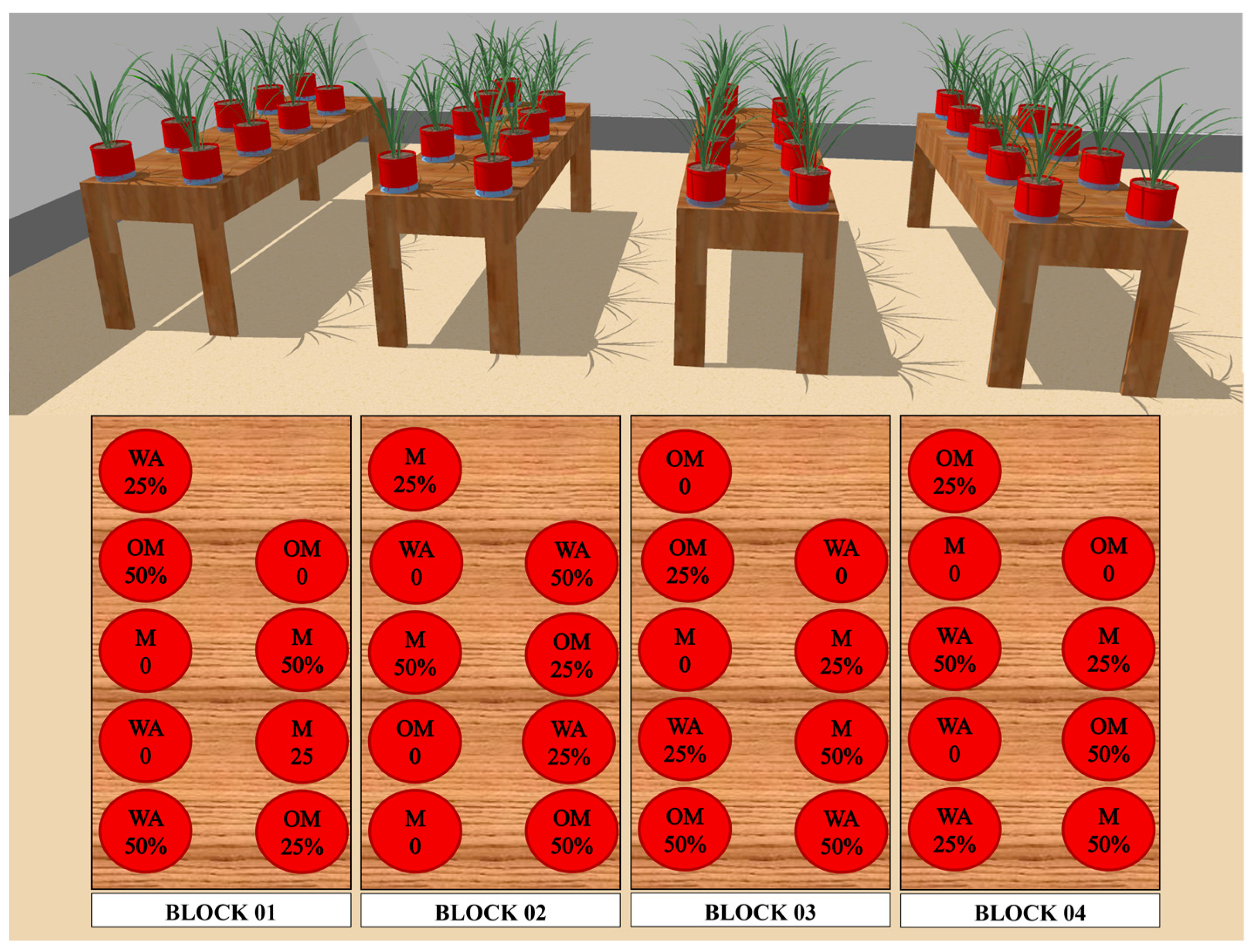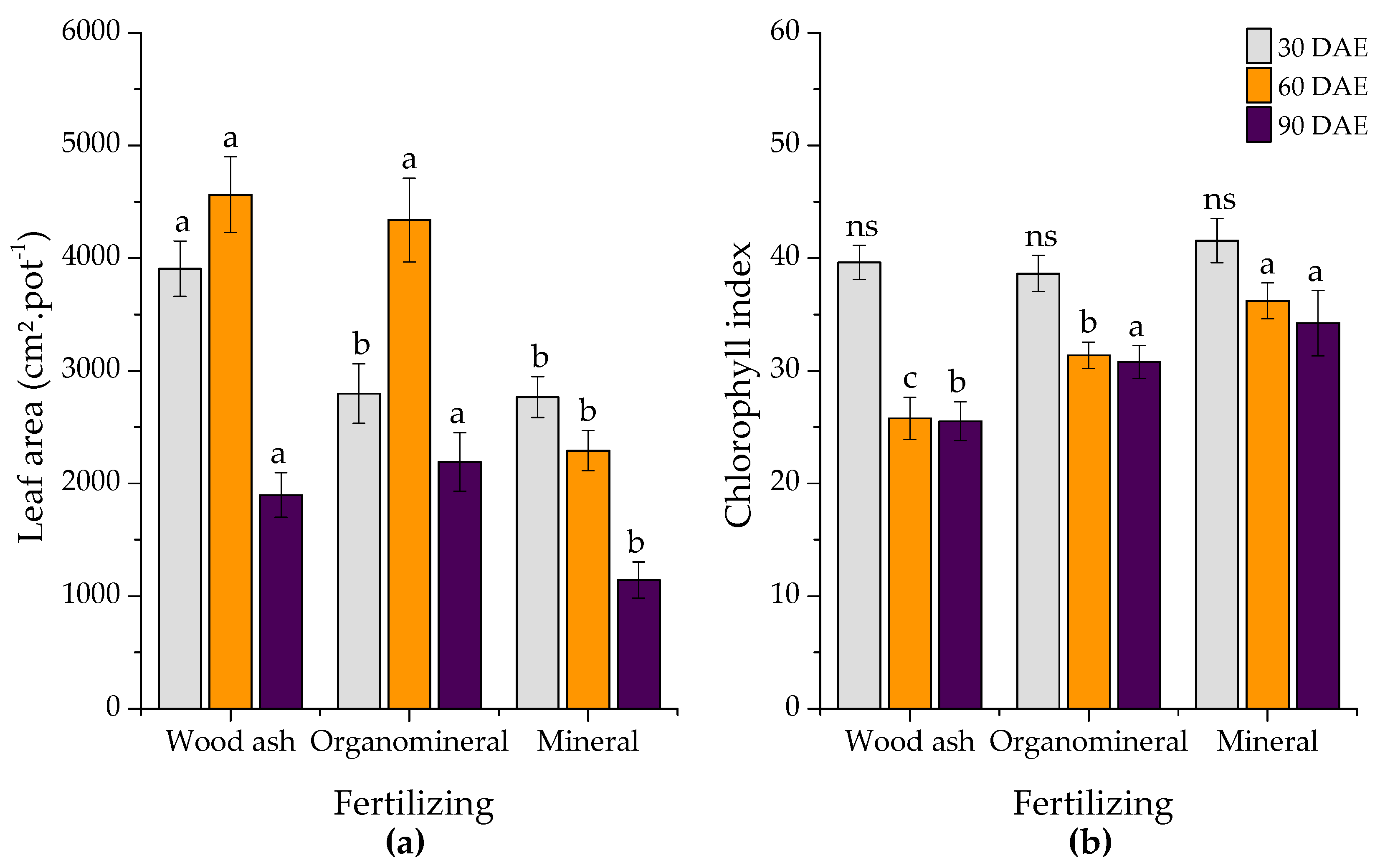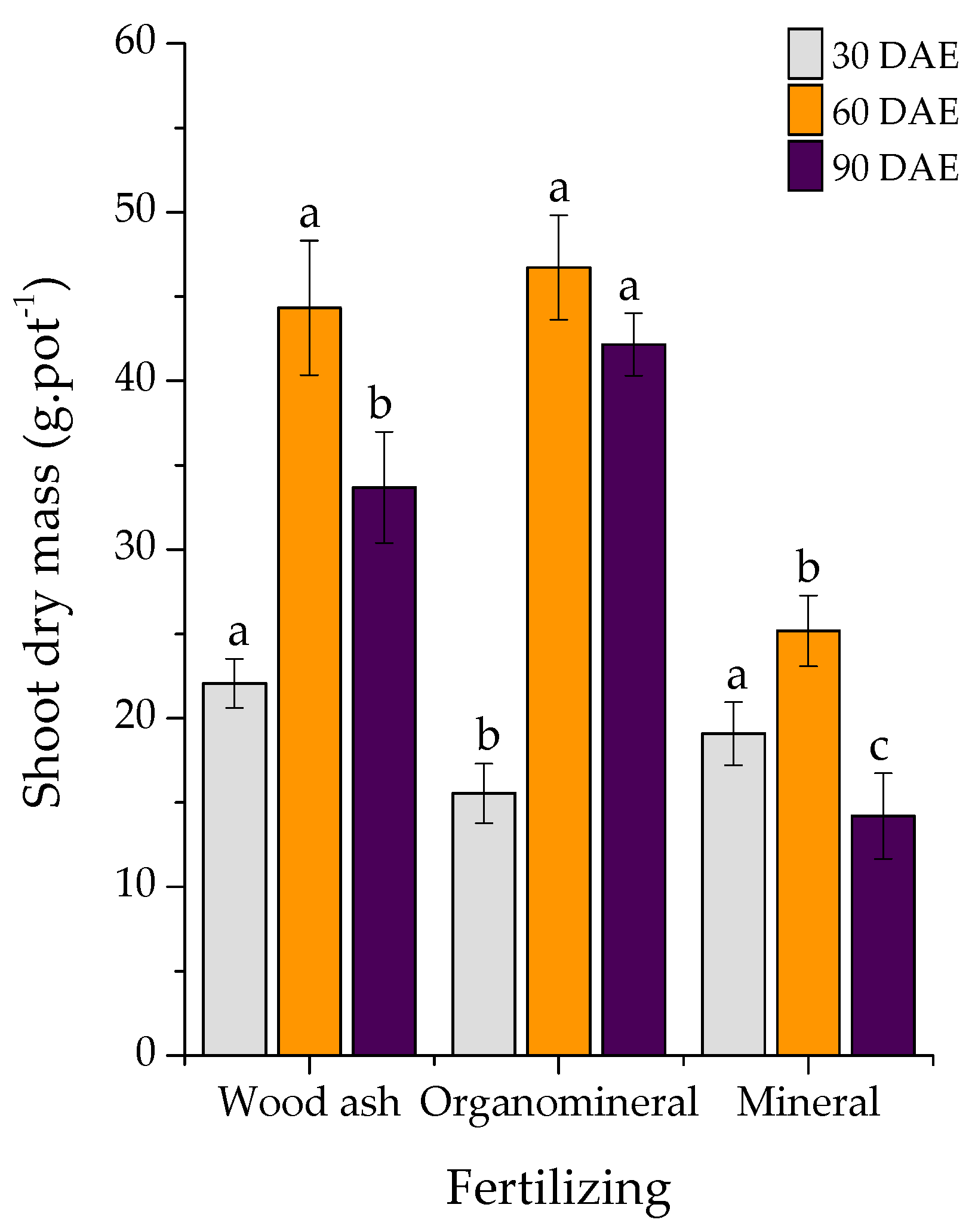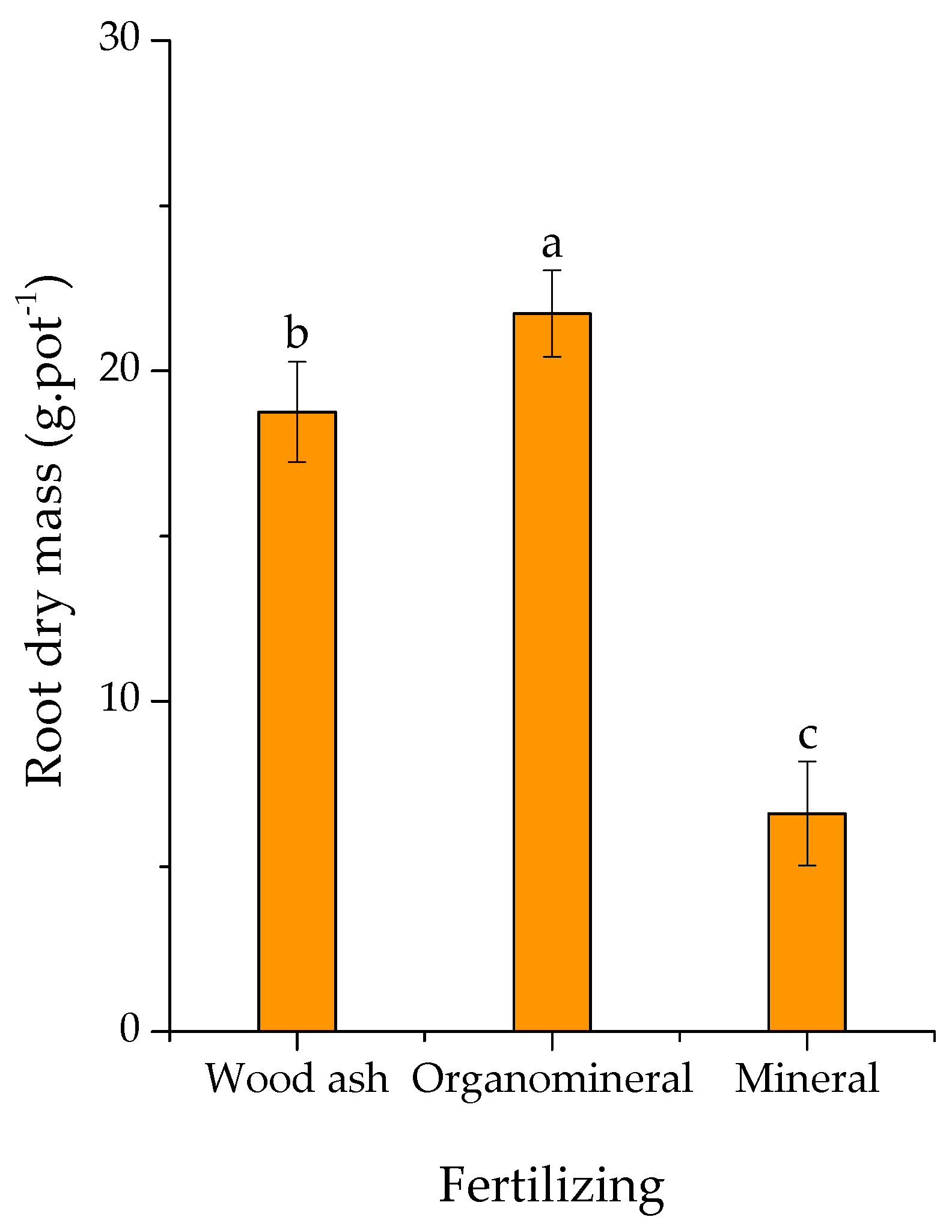Effects of Fertilization Types and Base Saturation on the Growth and Water Productivity in Panicum maximum cv. BRS Zuri
Abstract
:1. Introduction
2. Materials and Methods
2.1. Characterization of the Experimental Site
2.2. Experimental Design and Treatments
2.3. Nitrogen Fertilization, Seeding and Thinning
2.4. Irrigation Management
2.5. Analyzed Variables
2.6. Statistical Analysis
3. Results
3.1. Growth Variables of Zuri Grass under Different Fertilization Types and Base Saturation Levels
3.2. Water Consumption and Water Productivity of Zuri Grass under Different Fertilization Types and Base Saturation Levels
4. Discussion
5. Conclusions
- The OM fertilizer (WA+M) is an alternative that reduces dependence on synthetic fertilizers and helps mitigate environmental impacts.
- Base saturation levels did not individually or interactively influence the growth and water productivity of Zuri grass throughout the crop cycles, regardless of the types of fertilizers used.
- For every 1 L of water applied, an average of 5.0 g of Zuri grass dry matter was produced with WA and WA combined with mineral fertilizer (OM).
- It is noteworthy that the OM fertilization showed significant increases of 50% in leaf area, 66% in shoot dry mass, 70% in root dry mass, 41% in water consumption, and 50% in water productivity when compared to synthetic fertilizer.
- The OM fertilizer obtained from WA was a differentiator regarding improvements in the long-term supply of nutrients to crops.
Author Contributions
Funding
Institutional Review Board Statement
Data Availability Statement
Acknowledgments
Conflicts of Interest
References
- Tahat, M.M.; Alananbeh, K.M.; Othman, Y.A.; Leskovar, D.I. Soil health and sustainable agriculture. Sustainability 2020, 12, 489. [Google Scholar] [CrossRef]
- da Silva, E.B.; de Souza, C.M.S.; Furtado, R.N.; Lopes, M.N.; de Melo, B.M. Chemical composition of Panicum maximum ‘BRS Zuri’ subjected to levels of salinity and irrigation depths. Rev. Ciênc. Agron. 2020, 51, e20175997. [Google Scholar] [CrossRef]
- Duarte, T.F.; Bonfim-Silva, E.M.; da Silva, T.J.A.; Koetz, M.; Lima, G.F. Physical-hydric properties of Oxisol and Quartzipsamment associated with the application of wood ash. Rev. Bras. Eng. Agríc. Ambient. 2023, 27, 188–194. [Google Scholar] [CrossRef]
- Moragues-Saitua, L.; Arias-González, A.; Blanco, F.; Benito-Carnero, G.; Gartzia-Bengoetxea, N. Effects of biochar and wood ash amendments in the soil-water-plant environment of two temperate forest plantations. Front. For. Glob. Chang. 2023, 5, 87821. [Google Scholar] [CrossRef]
- Johan, P.D.; Ahmed, O.H.; Omar, L.; Hasbullah, N.A. Phosphorus transformation in soils following co-application of charcoal and wood ash. Agronomy 2021, 11, 2010. [Google Scholar] [CrossRef]
- Oliveira, W.C.M.; Bonfim-Silva, E.M.; Ferraz, A.P.F.; Guimarães, S.L.; Silva, T.J.A.; Duarte, T.F. Soil quality indicators for Urochloa brizantha fertilized with wood ash. Rev. Bras. Eng. Agríc. Ambient. 2023, 27, 241–249. [Google Scholar] [CrossRef]
- Bonfim-Silva, E.M.; Martinez-Santos, T.; da Silva, T.J.A.; Alves, R.D.S.; Pinheiro, E.A.R.; Duarte, T.F. Wood ash as a vegetative-growth promoter in soils with subsurface compaction. Rev. Bras. Eng. Agríc. Ambient. 2022, 26, 258–265. [Google Scholar] [CrossRef]
- Szpunar-Krok, E.; Szostek, M.; Pawlak, R.; Gorzelany, J.; Migut, D. Effect of fertilisation with ash from biomass combustion on the mechanical properties of potato tubers (Solanum tuberosum L.) grown in two types of soil. Agronomy 2022, 12, 379. [Google Scholar] [CrossRef]
- Bonfim-Silva, E.M.; Costa, A.S.; José, J.V.; Ferraz, A.P.F.; Damasceno, A.P.A.B.; Silva, T.J.A. Correction of acidity of a brazilian Cerrado Oxisol with limestone and wood ash on the initial growth of cowpea. Agric. Sci. 2019, 10, 841–851. [Google Scholar] [CrossRef]
- Bouhia, Y.; Hafidi, M.; Ouhdouch, Y.; Boukhari, M.M.; Mphatso, C.; Zeroual, Y.; Lyamlouli, K. Conversion of waste into organo-mineral fertilizers: Current technological trends and prospects. Rev. Environ. Sci. Biotechnol. 2022, 21, 425–446. [Google Scholar] [CrossRef]
- Magela, M.L.M.; Camargo, R.; Lana, R.M.Q.; Miranda, M.C.C. Application of organomineral fertilizers sourced from filter cake and sewage sludge can affect nutrients and heavy metals in soil during early development of maize. Aust. J. Crop Sci. 2019, 13, 863–873. [Google Scholar] [CrossRef]
- Bouhia, Y.; Hafidi, M.; Ouhdouch, Y.; Zeroual, Y.; Lyamlouli, K. Organo-Mineral fertilization based on olive waste sludge compost and various phosphate sources improves phosphorus agronomic efficiency, Zea mays agro-physiological traits, and water availability. Agronomy 2023, 13, 249. [Google Scholar] [CrossRef]
- Bouajila, K.; Hechmi, S.; Mechri, M.; Jeddi, F.B.; Jedidi, N. Short-term effects of sulla residues and farmyard manure amendments on soil properties: Cation exchange capacity (CEC), base cations (BC), and percentage base saturation (PBS). Arab. J. Geosci. 2023, 16, 410. [Google Scholar] [CrossRef]
- Rawal, A.; Chakraborty, S.; Li, B.; Lewis, K.; Godoy, M.; Paulette, L.; Weindorf, D.C. Determination of base saturation percentage in agricultural soils via portable X-ray fluorescence spectrometer. Geoderma 2019, 338, 375–382. [Google Scholar] [CrossRef]
- Javed, T.; Indu, I.; Singhal, R.K.; Shabbir, R.; Shah, A.N.; Kumar, P.; Jinger, D.; Dharmappa, P.M.; Shad, M.A.; Saha, D.; et al. Recent advances in agronomic and physio-molecular approaches for improving nitrogen use efficiency in crop plants. Front. Plant Sci. 2022, 13, 877544. [Google Scholar] [CrossRef]
- Guo, L.; Li, H.; Cao, X.; Cao, A.; Huang, M. Effect of agricultural subsidies on the use of chemical fertilizer. J. Environ. Manag. 2021, 299, 113621. [Google Scholar] [CrossRef]
- Pahalvi, H.N.; Rafiya, L.; Rashid, S.; Nisar, B.; Kamili, A.N. Chemical fertilizers and their impact on soil health. In Microbiota and Biofertilizers; Dar, G.H., Bhat, R.A., Mehmood, M.A., Hakeem, K.R., Eds.; Springer: Berlin/Heidelberg, Germany, 2021; Volume 2, pp. 1–20. [Google Scholar] [CrossRef]
- Bezerra, M.D.L.; Bonfim-Silva, E.M.; Silva, T.J.A.; Ferraz, A.P.F.; Damasceno, A.P.A.B. Phytometric characteristics and chlorophyll index of “Paiaguás” grass (Urochloa brizantha) as a function of wood ash doses and soil water stress. Aust. J. Crop Sci. 2019, 13, 1883–1891. [Google Scholar] [CrossRef]
- Bonfim-Silva, E.M.; Oliveira, N.P.R.; Mazero, H.M.; Alves, D.J.; Oliveira, J.R.; Silva, T.J.A. Production and morphophysiological responses of Panicum maximum cv. BRS Zuri to water availability. Aust. J. Crop Sci. 2022, 16, 1203–1211. [Google Scholar] [CrossRef]
- Sousa, D.M.G.; Lobato, E. Correção da acidez do solo. In Cerrado: Correção do Solo e Adubação, 2nd ed.; Sousa, D.M.G., Lobato, E., Eds.; Embrapa Informação Tecnológica: Brasília, Brazil, 2004; pp. 81–96. [Google Scholar]
- Embrapa—Empresa Brasileira de Pesquisa Agropecuária. BRS Zuri, Produção e Resistência Para a Pecuária; Embrapa Gado de Corte: Campo Grande, Brazil, 2014; pp. 1–2. Available online: https://ainfo.cnptia.embrapa.br/digital/bitstream/item/123642/1/Folder-Zuri-Final-2014.pdf (accessed on 27 July 2023).
- Ferreira, D.F. Sisvar: A computer analysis system to fixed effects split plot type designs. Rev. Bras. Biom. 2019, 37, 529–535. [Google Scholar] [CrossRef]
- Taiz, L.; Zeiger, E.; Møller, I.M.; Murphy, A. Fisiologia e Desenvolvimento Vegetal, 6th ed.; Artmed: Porto Alegre, Brazil, 2017; p. 888. [Google Scholar]
- Tan, T.; Li, S.; Fan, Y.; Wang, Z.; Raza, M.A.; Shafiq, I.; Wang, B.; Wu, X.; Yong, T.; Wang, X.; et al. Far-red light: A regulator of plant morphology and photosynthetic capacity. Crop J. 2022, 10, 300–309. [Google Scholar] [CrossRef]
- Gheith, E.M.S.; El-Badry, O.Z.; Lamlom, S.F.; Ali, H.M.; Siddiqui, M.H.; Ghareeb, R.Y.; El-Sheikh, M.H.; Jebril, J.; Abdelsalam, N.R.; Kandil, E.E. Maize (Zea mays L.) productivity and nitrogen use efficiency in response to nitrogen application levels and time. Front. Plant Sci. 2022, 13, 941343. [Google Scholar] [CrossRef] [PubMed]
- Paramisparam, P.; Ahmed, O.H.; Omar, L.; Ch’ng, H.Y.; Johan, P.D.; Hamidi, N.H. Co-application of charcoal and wood ash to improve potassium availability in tropical mineral acid soils. Agronomy 2021, 11, 2081. [Google Scholar] [CrossRef]
- Bonfim-Silva, E.M.; Oliveira, E.S.; Bezerra, M.D.L.; Castañon, T.H.F.M.; Fenner, W.; Silva, T.J.A. Application of wood ash, organomineral and mineral fertilizers to increase the growth of arugula (Eruca sativa Miller) at different base saturation on Oxisol. J. Exper. Agricul. Int. 2017, 17, 1–6. [Google Scholar] [CrossRef]
- Xiong, D.; Chen, J.; Yu, T.; Gao, W.; Ling, X.; Li, Y.; Peng, S.; Huang, J. SPAD-based leaf nitrogen estimation is impacted by environmental factors and crop leaf characteristics. Sci. Rep. 2015, 5, 13389. [Google Scholar] [CrossRef]
- Carvalho, C.L.M.; Duarte, A.N.; Hungria, M.; Nogueira, M.A.; Moreira, A.; Soares Filho, C.V. Nitrogen in shoots, number of tillers, biomass yield and nutritive value of Zuri guinea grass inoculated with plant-growth promoting bacteria. Int. J. Innov. Educ. Res. 2020, 8, 437–463. [Google Scholar]
- Shibaeva, T.G.; Mamaev, A.V.; Sherudilo, E.G. Evaluation of a SPAD-502 Plus Chlorophyll Meter to estimate chlorophyll content in leaves with interveinal chlorosis. Russ. J. Plant Physiol. 2020, 67, 690–696. [Google Scholar] [CrossRef]
- Anas, M.; Liao, F.; Verma, K.K.; Sarwar, M.A.; Mahmood, A.; Chen, Z.L.; Li, Q.; Zeng, X.P.; Liu, Y.; Li, Y.R. Fate of nitrogen in agriculture and environment: Agronomic, eco-physiological and molecular approaches to improve nitrogen use efficiency. Biol. Res. 2020, 53, 47. [Google Scholar] [CrossRef]
- Chattha, M.S.; Ali, Q.; Haroon, M.; Afzal, M.J.; Javed, T.; Hussain, S.; Mahmood, T.; Solanki, M.K.; Umar, A.; Abbas, W.; et al. Enhancement of nitrogen use efficiency through agronomic and molecular based approaches in cotton. Front. Plant Sci. 2022, 13, 994306. [Google Scholar] [CrossRef]
- Kominko, H.; Gorazda, K.; Wzorek, Z. The possibility of organo-mineral fertilizer production from sewage sludge. Waste Biomass Valor. 2017, 8, 1781–1791. [Google Scholar] [CrossRef]
- Fernandes, D.M.; Grohskopf, M.A.; Gomes, E.R.; Ferreira, N.R.; Büll, L.T. Fósforo na solução do solo em resposta à aplicação de fertilizantes fluidos mineral e organomineral. Irriga 2015, 1, 14–27. [Google Scholar] [CrossRef]
- García-González, J.; Lacek, J.; Retzer, K. Dissecting hierarchies between light, sugar and auxin action underpinning root and root hair growth. Plants 2021, 10, 111. [Google Scholar] [CrossRef] [PubMed]
- Huang, G.; Zhang, D. The plasticity of root systems in response to external phosphate. Int. J. Mol. Sci. 2020, 21, 5955. [Google Scholar] [CrossRef] [PubMed]
- Wang, L.; Li, X.; Mang, M.; Ludewig, U.; Shen, J. Heterogeneous nutrient supply promotes maize growth and phosphorus acquisition: Additive and compensatory effects of lateral roots and root hairs. Ann. Bot. 2021, 128, 431–440. [Google Scholar] [CrossRef] [PubMed]
- Cabral, C.E.A.; Cabral, L.S.; Bonfim-Silva, E.M.; Carvalho, K.S.; Abreu, J.G.; Cabral, C.H.A. Reactive natural phosphate and nitrogen fertilizers in Marandu grass fertilization. Comun. Sci. 2018, 9, 729–736. [Google Scholar] [CrossRef]
- Silva, C.T.R.; Bonfim-Silva, E.M.; Silva, T.J.A.; Pinheiro, E.A.R.; José, J.V.; Ferraz, A.P.F. Yield component responses of the Brachiaria brizantha forage grass to soil water availability in the brazilian Cerrado. Agriculture 2020, 10, 13. [Google Scholar] [CrossRef]
- de Ollas, C.; Segarra, C.; Blázquez, M.A.; Agustí, J.; Gómez-Cadenas, A. Plant size directly correlates with water use efficiency in Arabidopsis. Plant Cell Environ. 2023, 46, 2711–2725. [Google Scholar] [CrossRef]
- Hamidi, N.H.; Ahmed, O.H.; Omar, L.; Ch’ng, H.Y. Soil nitrogen sorption using charcoal and wood ash. Agronomy 2021, 11, 1801. [Google Scholar] [CrossRef]
- Bonfim-Silva, E.M.; Fernandes, G.B.; Alves, R.D.S.; Castañon, T.H.F.M.; Silva, T.J.A. Mineral, organic and organomineral fertilization in rabanet culture. Braz. J. Dev. 2020, 6, 23300–23318. [Google Scholar] [CrossRef]
- Hatfield, J.L.; Dold, C. Water-use efficiency: Advances and challenges in a changing climate. Front. Plant Sci. 2019, 10, 103. [Google Scholar] [CrossRef]
- Li, X.; Farooqi, T.J.A.; Jiang, C.; Liu, S.; Sun, O.J. Spatiotemporal variations in productivity and water use efficiency across a temperate forest landscape of northeast China. For. Ecosyst. 2019, 6, 22. [Google Scholar] [CrossRef]
- Cao, X.; Xiao, J.; Wu, M.; Zeng, W.; Huang, X. Agricultural water use efficiency and driving force assessment to improve regional productivity and effectiveness. Water Res. Manag. 2021, 35, 2519–2535. [Google Scholar] [CrossRef]
- El-Nashar, W.; Elyamany, A. Adapting irrigation strategies to mitigate climate change impacts: A value engineering approach. Water Res. Manag. 2023, 37, 2369–2386. [Google Scholar] [CrossRef]





| pH | SB | CEC | Al | H + Al | MO | V | M | Sand | Silt | Clay |
|---|---|---|---|---|---|---|---|---|---|---|
| CaCl2 | --------------------cmolc dm−3-------------------- | --------------------------------------%--------------------------------------- | ||||||||
| 4.3 | 0.8 | 5.6 | 0.6 | 4.8 | 2.13 | 13.5 | 44.4 | 33.0 | 10.0 | 57.0 |
| P | K | S | Ca | Mg | B | Cu | Fe | Mn | Zn | |
| ---------------mg dm−3-------------- | -----cmolc dm−3----- | ----------------------------mg dm−3-------------------------- | ||||||||
| 1.5 | 18.0 | 2.0 | 0.5 | 0.2 | 0.15 | 0.2 | 64.0 | 21.8 | 0.7 | |
| pH | N | P2O5 | K2O | Ca | Mg | SO4 | B | Cu | Fe | Mn | Zn | CaO | MgO | PN | PRNT |
|---|---|---|---|---|---|---|---|---|---|---|---|---|---|---|---|
| CaCl2 | ----------------------------------------------------------g kg−1--------------------------------------------------------- | -------%------- | |||||||||||||
| 10.67 | 4.9 | 7.9 | 32.5 | 49.6 | 42.0 | 6.0 | 0.4 | 0.1 | 7.2 | 0.4 | 0.2 | 91.0 | 65.0 | 30.0 | 24.8 |
| SV | DF | Statistic F | |||||||||
|---|---|---|---|---|---|---|---|---|---|---|---|
| LA (cm2.pot−1) | CI | SDM (g.pot−1) | RDM (g.pot−1) | ||||||||
| 30 DAE | 60 DAE | 90 DAE | 30 DAE | 60 DAE | 90 DAE | 30 DAE | 60 DAE | 90 DAE | 90 DAE | ||
| Block | 3 | 0.64 ns | 1.35 ns | 1.04 ns | 1.41 ns | 0.37 ns | 1.49 ns | 0.55 ns | 0.14 ns | 0.68 ns | 1.06 ns |
| Fertilizing | 2 | 19.01 *** | 48.46 *** | 19.07 *** | 2.14 ns | 27.15 *** | 10.54 *** | 9.77 *** | 37.24 *** | 69.34 *** | 75.22 *** |
| Base saturation | 2 | 0.50 ns | 2.51 ns | 0.22 ns | 0.45 ns | 1.17 ns | 1.92 ns | 0.80 ns | 0.12 ns | 0.22 ns | 0.80 ns |
| Fertilizing × Base saturation | 4 | 0.45 ns | 1.01 ns | 0.58 ns | 2.40 ns | 0.64 ns | 0.17 ns | 0.22 ns | 0.34 ns | 0.57 ns | 0.15 ns |
| Error | 24 | ||||||||||
| CV (%) | 16.33 | 16.71 | 24.6 | 8.86 | 11.13 | 15.51 | 19.14 | 17.31 | 21,24 | 19.08 | |
| Overall average | 3156.97 | 3731.31 | 1753.46 | 39.93 | 31.13 | 30.18 | 18.90 | 38.74 | 15.70 | 30.01 | |
| Variables | LA 30 | LA 60 | LA 90 |
|---|---|---|---|
| CI 30 | 0.08 ns | −0.19 ns | 0.09 ns |
| CI 60 | −0.64 * | −0.58 * | −0.48 * |
| CI 90 | −0.44 * | −0.49 * | −0.43 * |
| Variables | SDM 30 | SDM 60 | SDM 90 | RDM |
|---|---|---|---|---|
| LA30 | 0.58 * | 0.41 * | 0.29 ns | 0.32 ns |
| LA60 | −0.03 ns | 0.84 * | 0.71 * | 0.76 * |
| LA90 | −0.01 ns | 0.72 * | 0.84 * | 0.76 * |
| CI 30 | 0.20 ns | −0.20 ns | −0.21 ns | −0.25 ns |
| CI 60 | −0.37 * | −0.60 * | −0.56 * | −0.58 * |
| CI 90 | −0.22ns | −0.44 * | −0.37 * | −0.39 * |
| SD | DF | Statistic F | |||||
|---|---|---|---|---|---|---|---|
| WC (L.pot−1) | WP (g.L−1) | ||||||
| 30 DAE | 60 DAE | 90 DAE | 30 DAE | 60 DAE | 90 DAE | ||
| Block | 3 | 0.44 ns | 0.16 ns | 1.83 ns | 0.36 ns | 0.21 ns | 0.77 ns |
| Fertilizing | 2 | 4.95 * | 4.71 * | 49.74 *** | 3.27 ns | 53.21 *** | 55.77 *** |
| Base saturation | 2 | 0.30 ns | 0.84 ns | 1.39 ns | 0.38 ns | 0.35 ns | 1.64 ns |
| Fertilizing × Base saturation | 4 | 0.94 ns | 1.56 ns | 0.12 ns | 0.47 ns | 1.43 ns | 0.23 ns |
| Error | 24 | ||||||
| CV (%) | 11.04 | 9.29 | 13.29 | 19.93 | 12.21 | 12.76 | |
| Overall average | 6.07 | 9.31 | 5.53 | 3.12 | 4.12 | 5.16 | |
| Variables | CI 30 | CI 60 | CI 90 | LA 30 | LA 60 | LA 90 | SDM 30 | SDM 60 | SDM 90 | RDM |
|---|---|---|---|---|---|---|---|---|---|---|
| WC 30 | 0.40 * | −0.20 ns | −0.05 ns | 0.49 * | −0.20 ns | −0.09 ns | 0.49 * | −0.10 ns | −0.15 ns | −0.12 ns |
| WC 60 | −0.12 ns | −0.40 * | −0.29 ns | 0.39 * | 0.43 * | 0.29 ns | −0.04 ns | 0.66 * | 0.51 * | 0.55 * |
| WC 90 | −0.21 ns | −0.64 * | −0.46 * | 0.35 * | 0.70 * | 0.77 * | 0.08 ns | 0.76 * | 0.94 * | 0.94 * |
| WP 30 | −0.01 ns | −0.25 ns | −0.22 ns | 0.34 * | 0.04 ns | 0.03 ns | 0.85 * | −0.01 ns | −0.16 ns | −0.01 ns |
| WP 60 | −0.21 ns | −0.57 * | −0.43 * | 0.33 ns | 0.85 * | 0.78 * | −0.06 ns | 0.96 * | 0.81 * | 0.83 * |
| WP 90 | −0.22 ns | −0.47 * | −0.27 ns | 0.23 ns | 0.68 * | 0.80 * | −0.16 ns | 0.81 * | 0.94 * | 0.87 * |
Disclaimer/Publisher’s Note: The statements, opinions and data contained in all publications are solely those of the individual author(s) and contributor(s) and not of MDPI and/or the editor(s). MDPI and/or the editor(s) disclaim responsibility for any injury to people or property resulting from any ideas, methods, instructions or products referred to in the content. |
© 2023 by the authors. Licensee MDPI, Basel, Switzerland. This article is an open access article distributed under the terms and conditions of the Creative Commons Attribution (CC BY) license (https://creativecommons.org/licenses/by/4.0/).
Share and Cite
de Oliveira, N.P.R.; Bonfim-Silva, E.M.; da Silva, T.J.A.; da Silva, P.F.; da Silva Rocha, R.A.; Meneghetti, L.A.M.; Custódio, A.S.C.; Guimarães, S.L.; Duarte, T.F.; Koetz, M. Effects of Fertilization Types and Base Saturation on the Growth and Water Productivity in Panicum maximum cv. BRS Zuri. Agriculture 2023, 13, 1872. https://doi.org/10.3390/agriculture13101872
de Oliveira NPR, Bonfim-Silva EM, da Silva TJA, da Silva PF, da Silva Rocha RA, Meneghetti LAM, Custódio ASC, Guimarães SL, Duarte TF, Koetz M. Effects of Fertilization Types and Base Saturation on the Growth and Water Productivity in Panicum maximum cv. BRS Zuri. Agriculture. 2023; 13(10):1872. https://doi.org/10.3390/agriculture13101872
Chicago/Turabian Stylede Oliveira, Niclene Ponce Rodrigues, Edna Maria Bonfim-Silva, Tonny José Araújo da Silva, Patrícia Ferreira da Silva, Rosana Andréia da Silva Rocha, Luana Aparecida Menegaz Meneghetti, Alisson Silva Costa Custódio, Salomão Lima Guimarães, Thiago Franco Duarte, and Marcio Koetz. 2023. "Effects of Fertilization Types and Base Saturation on the Growth and Water Productivity in Panicum maximum cv. BRS Zuri" Agriculture 13, no. 10: 1872. https://doi.org/10.3390/agriculture13101872
APA Stylede Oliveira, N. P. R., Bonfim-Silva, E. M., da Silva, T. J. A., da Silva, P. F., da Silva Rocha, R. A., Meneghetti, L. A. M., Custódio, A. S. C., Guimarães, S. L., Duarte, T. F., & Koetz, M. (2023). Effects of Fertilization Types and Base Saturation on the Growth and Water Productivity in Panicum maximum cv. BRS Zuri. Agriculture, 13(10), 1872. https://doi.org/10.3390/agriculture13101872






